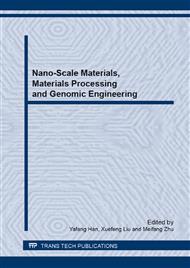p.314
p.320
p.328
p.336
p.344
p.350
p.355
p.362
p.370
Sliding Wear Behavior of Forged, Uncoated and Laser Nitrided LMD TC18 Titanium Alloy
Abstract:
Recently, laser melting deposition (LMD) undergoes rapid development since its fabricating advantages make it particularly suitable for the fabrication of titanium aerospace components. The dry sliding wear behavior of forged, uncoated and laser nitrided LMD TC18 titanium alloy sliding against the forged TA15 alloy were investigated. Then, reasons of their wear behavior were further studied. The specimens were tested on the M-200 tester, worn surface morphology and wear debris were carefully analyzed by means of SEM and EDS. The results show that in the case of forged and LMD TC18 titanium alloy sliding against TA15 alloy, wear mechanism are abrasive wear and adhesive wear. Because of the lubricious nature of TiO2 oxides produced during sliding which reduces the wear and consequently wear loss, the wear resistance of forged TC18 titanium alloy is superior to that of LMD TC18 titanium alloy. After using laser nitriding treatment on LMD TC18 alloy, the formation of a protective layer composed of dendritic TiN attributes to significant wear resistance improvement.
Info:
Periodical:
Pages:
344-349
Citation:
Online since:
April 2014
Authors:
Price:
Сopyright:
© 2014 Trans Tech Publications Ltd. All Rights Reserved
Share:
Citation:


